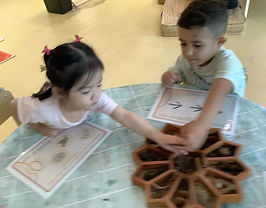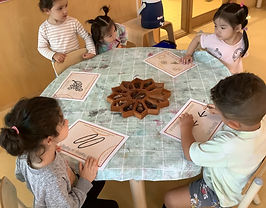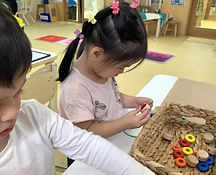Journal and Reflection: Week 8
(01April– 05April 2024)
Food Construction: Exploring Engineering in STEAM
This activity draws on children's interest in STEAM by mixing engineering and construction with eating. We utilize fruits and other food materials to make structures, allowing them to explore concepts such as balance and stability experience. This exercise, which combines STEAM principles with children's interests, gives a fun yet informative experience. Designing and creating edible buildings allows children to learn about engineering topics while also exercising their imagination.
This experiment is precisely aligned with STEAM, which stands for science, technology, engineering, art, and mathematics. It provides a fascinating way for children to learn about construction and engineering while also developing critical thinking and problem-solving skills via exploration and creation.
Link to:
-
National Quality Standards Q1 Educational Program and Practice
-
Australian Teaching Standards 2.5 Literacy and numeracy strategies
-
Australian Teaching Standards 4.1 Support Student Participation
-
Australian Teaching Standards 6.3 Engage with colleagues and improve practice
-
EYLF Principle. Critical Reflection and Ongoing Professional Learning
-
EYLF Outcome 4. Children are confident and involved learners
-
EYLF Outcome 5. Children are effective communicators
-
Play pedagogy: Learning through games, Purposefully-framed play
Today, we guided children in an engaging and hands-on exercise called "Fruit Construction." The goal was to promote creativity and fine motor abilities by investigating different fruits. We began by explaining the concept of fruit construction to the children. We discussed all of the fruits we had available and how they might be used to create imaginative structures.
The children were given time to plan and design their fruit creations. They were asked to think about the shapes, colours, and patterns they intended to include in their designs. With their goals in mind, children began building their fruit creations, using toothpicks to keep the fruits together and experimenting with various arrangements to bring the designs to life. Throughout the activity, children were encouraged to investigate the fruits, discuss their qualities, and be creative in their constructions. They worked together to share ideas and aid each other with their creations.
Following the presentations, we conducted a reflection session with the children. We spoke about how much they enjoyed the activity, what they learned about the fruits, and how they felt about their creations.





Singing "Inanay Gupta Wana" in a Circle
Link to:
-
National Quality Standards Q1 Educational Program and Practice
-
Australian Teaching Standards 2.1 Content and teaching strategies of the teaching area
-
Australian Teaching Standards 2.4 Understand and respect Aboriginal and Torres Strait Islander people to promote reconciliation between Indigenous and non-Indigenous Australians.
-
EYLF Principles. Aboriginal and Torres Strait Islander perspectives
-
EYLF Practices. Cultural responsiveness
-
EYLF Learning Outcome 2. Children are connected with and contribute to their world
-
Play pedagogy: Purposefully framed play, Modelled play
-
Teaching Strategies: Sustained shared thinking, co-constructing, facilitating
Today, our preschoolers participated in an enjoyable exercise, singing "Inanay Gupta Wana," a conventional Indigenous Australian ballad. This activity functioned as a daily routine in which our preschoolers recognised and appreciated the ancestral owners of the land where we study and play. They swayed lightly while singing, fostering a sense of solidarity and connection among the group members.
Observing preschoolers sing "Inanay Gupta Wana" brought me much delight and pride. It was a magnificent expression of their admiration and respect for Native Australian culture. By adding this cultural song within our daily activities, we provide our preschoolers the opportunity to get a better awareness of and connection with their country's rich cultural past.
As children formed a circle, moving their hands and body following the song's rhythm, the very beautiful scene showed the group's sense of belonging and unity. By this communal experience, children additionally respected the existing tradition, yet also created a sense of belonging in our classroom environment. It was encouraging to see how they accepted the variances in each other and celebrated our community's variety.
Music helps them develop the way of thinking, interacting with others, and emotional balance. As they sing and dance together, they promote vocabulary growth, experience rhythm, and synchronize balance. Furthermore, addressing the cultural song encourages compassion and respect, which improves their interactions with others and the ability to face conflicts.
Exploring Indigenous Community
Through Symbols
Link to:
-
National Quality Standards Q1 Educational Program and Practice
-
Australian Teaching Standards 2.1 Content and teaching strategies of the teaching area
-
Australian Teaching Standards 2.4 Understand and respect Aboriginal and Torres Strait Islander people to promote reconciliation between Indigenous and non-Indigenous Australians.
-
EYLF Principles. Aboriginal and Torres Strait Islander perspectives
-
EYLF Practices. Cultural responsiveness
-
EYLF Learning Outcome 2. Children are connected with and contribute to their world
-
Play pedagogy: Purposefully framed play, Modelled play
-
Teaching Strategies: Sustained shared thinking, co-constructing, facilitating
The goal of the activity of exploring indigenous symbols was to introduce children to Indigenous cultures' rich history and heritage through an exploration of daily used symbols of their traditions. This exploration activity is also to promote awareness of culture, appreciation, and appreciation while fostering creativity and self-expression.
During this morning's lesson, children embarked on a journey of discovery, exploring some symbols associated with Indigenous communities. They discovered the meanings and heritage behind the symbols through dreamtime stories or totems, such as bush berry, digging, clapping, emu tracks, etc. Children were then asked to shape the symbols with natural materials.
Seeing children interact with Native symbols was a strong reminder of the value of cultural immersion in curriculum. As they engaged in stories and explored the symbols, their interest stimulated and they asked smart questions about the meanings of each symbol. It was encouraging to see their genuine curiosity and acceptance of Indigenous culture, which reflected an underlying basis of empathy and inclusion.
Using Indigenous symbols produced significant discussions between children. They showed empathy and compassion by sharing their ideas and feelings, acknowledging the diversity and depth of Indigenous communities. It was clear that using this exercise, children were gaining awareness as a global citizen, laying the framework for a more diverse and equal community.



Engaging in Fine Motor Activity: Bead Threading Activity
The goal of today's exercise was to help children improve their hand-eye coordination and motor skills by threading beads. The goal was to foster concentration, precision, and creativity by giving beads in many different kinds of shapes and sizes, and with hole sizes suited for their age and ability.
During today's exercise, children were supplied with a variety of shaped and sized beads, as well as a length of string. The beads has been selectively chosen to correspond with children at their developmental stage, with just enough bigger holes to allow them to develop their motor abilities. The children threaded the beads to the string while supervised by educators, producing bright patterns and motifs.
Seeing the children weave beads through the string was wonderful. They were not only practicing their hand-eye coordination by carefully handling the beads, yet they were also developing patience and focus. It was wonderful to watch their focus grow as they became immersed in the activity, weaving each bead with accuracy and care.
While children creatively select the beads, they start experimenting with a combination of colors and patterns. Some children prefer to design first, while others embrace threading spontaneously and imaginatively. This opportunity of self-expression through bead threading fostered innovative thinking and problem-solving abilities as they established the beads' various shapes and sizes.
Bead threading is also educationally important to foster cognitive and social-emotional development. This activity helps children improve spatial awareness, and focus to detail. Furthermore, having collaborative talks with peers improves communication skills and fosters teamwork.



